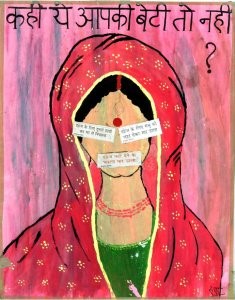

The 1929 Child Marriage Restraint Act (CMRA) in India was a seminal moment for girls in India and has received attention from feminists and women’s rights reformers ever since. However, as Ishita Pande has demonstrated, the Act was also significant for children’s rights in India, a moment in which marriage and sexual innocence was used to give numerical definition to the boundary between adulthood and childhood.[1] In many ways the 1929 Act was exceptional and remains a turning point in the history of childhood and in regarding children as rights-bearers in South Asia. It demonstrated Indian participation in constructions of a universal category of childhood (as both ‘natural’ and ‘ubiquitous’) and defined by digits of age, regardless of community. Yet as a social historian I am interested in the wider context in which this legislation emerged. By looking at social reform in the South of British India, it becomes clear that the CMRA was particularly symbolic as being at an all-India level, but that the ideas about childhood expressed within it were not new but reflected wider changes in the discourse surrounding childhood which had been happening over the previous decade.
My own research considers the emergence of new ideas of childhood in the Madras Presidency across the 1920s and 1930s. This can be seen in a range of measures based around the provincial and municipal governments as well as the contributions of experts, philanthropists and social reformers in evidence to the Age of Consent (Joshi) Committee in 1928. The CMRA was not the first act which sought to define the legal boundaries of childhood. The Madras Children Act 1920 also signified a new departure in the relationship between the state and the child, an Act mirrored in a number of the Presidencies. The Act legally defined the child as different from adults and initiated the expansion of a justice system centred on the specific needs of the child. This also radically redefined the state’s responsibility for both the ‘dangerous’ or criminal child and the child ‘in danger’ as a result of destitution or irresponsible parenting (Clause 29). This was almost entirely modelled on the British Children Act of 1908 and both Acts were the result of, and spawned, an increasingly global discourse of reformative penology which emphasised the uniqueness of the individual child as a rights-bearing future citizen and the responsibility of the State to care for the vulnerable child. As well as providing practical provisions for the reformation of children in Certified Schools, the discussions surrounding the Act established that the Indian delinquent child was no better or worse than other juvenile offenders across the globe (specifically London, Paris or New York) and was therefore worthy of the same protection and rehabilitation.
This was mirrored in other reforms, for example the Madras Elementary Education Act 1920 and then the introduction of Compulsory Education in Madras City in 1925. While these measures produced variable numerical definitions of what it meant to be a child, they contributed to an emerging discourse which characterised all children as malleable, innocent and vulnerable. This claim to universality for the Indian child challenged colonial racial hierarchies predicated on the intellectual backwardness, but also sexual precocity, of the Indian child.[2] Noticeably the child was discussed as a ‘future citizen’ by both social reformers and by Indians participating in dyarchical government, suggesting that they justified care and expenditure as an investment in a ‘future citizen’ and therefore the future nation.
The wide variety of new ideas about childhood circulating within elite and educated circles in the Madras Presidency were seen in the evidence provided to the Joshi Committee.[3] The numerical boundaries of childhood established in the Act were contested, ultimately the age of marriage for males was fixed at 18 years, for females 14 years, and the age of consent outside marriage at 16 years for girls. This built on existing legislative provisions which established marriage as a legal boundary of childhood for the girl (with the transfer of authority over the girl from the parents to husband), and moved the definition of maturity from a religiously significant but highly individualised experience of puberty linked to consent, to a generic, numerically defined and more easily policed definition linked to marriage. Crucially, this also entrenched the idea that sexual innocence was a key characteristic of childhood.
Other ideas emerge in the evidence too. Even though the details were contested and experts such as Dr Lazarus, Superintendent of the Government Victoria Caste and Gosha Hospital and Miss L Krishnabai, Secretary of the League of Youth, disagreed over whether the biological consequences of sex were different depending on whether it took place within or outside marriage, it was clear that a girl who had sex could no longer be a child and that childhood was characterised by biological immaturity.[4] A number of doctors, such as Dr Muthulakshmi Reddi expressed concern that early sexual contact would impact the girl’s mental health and lead to long-term anxiety issues, perhaps causing the ‘pre-adolescent mind’ to become ‘fearful and the worse cases unbalanced’ or even – according to Mrs Kamala-Devi Chattopadhyaya of the All India Women’s Council – could make a girl suicidal.[5] This intersects with different, although complementary, emerging discourses in the educational context which highlighted the natural psychological development of the normal child, as seen in the works of Piaget, Dewey and other child psychologists who were frequently cited in Indian pedagogical journals, such as Educational India, from around 1920s. Traumatic experiences upset this universal developmental sequence, blurring the boundaries between adult and child.
Likewise, a number of contributors also stressed that to be an adult, the girl had to be sufficiently mature to give ‘considered consent’, with an understanding of both the short-term implications and ‘enormity of the consequences’, particularly of childbirth and childcare.[6] This was a different definition of childhood, which associates the child with the irrational, and locates the difference between adult and child in the development of reason. Under this definition, adulthood is linked to the capacity for rational thought, and an understanding of the wider world, in which ‘consent’ involves an act of reason, deliberation and ability to make moral judgements.[7] Furthermore, childhood was also defined by playfulness, and ‘young unmarried girls’ were described as ‘bright, cheerful and healthy’[8]. Playfulness, emotional, physical and developmental immaturity combined with the inability to make rational decisions all contributed to 1920s understandings of what it meant to be ‘a child’ and contributed to the views of childhood encapsulated in the CMRA.
These mirrored ideas about childhood which were becoming accepted globally in the 1920s and which were enshrined in the League of Nations 1924 Declaration of the Rights of the Child. This was not merely a document formulated in Geneva but was engaged with critically by a number of organisations and individuals on the subcontinent. Dr Muthulaksmi Reddi, for example, as a medical doctor, legislator and prominent children and women’s rights campaigner, employed the universal language of children’s rights in her speeches to the Madras Legislative Council. Whether agitating for state intervention to protect children’s health, to improve juvenile justice provision or to end trafficking she argued that legislation concerned ‘the sacred rights of children and the rights of humanity’[9] and in her memoirs she claimed ’It is recognised by all civilised nations that the first and primary duty of the State is to secure for every child the right to be bodily, mentally and socially fit’ [my italics].[10] While Reddi is perhaps an exceptional case in the breadth of her interests and connections, I think she is symbolic of the wider civil society in which she operated, in which a discourse of children’s rights was increasingly deployed as a stimulus for state action. So, while 1929 Act was a significant moment in the understanding of constructions of childhood and children’s rights in India, we can see that the ideas it contained were both informed by and informed other interventions in the lives of children (in areas such as health, education and juvenile justice) and contributed to a multi-stranded and certainly not homogeneous emerging discourse of childhood. This moved away from ideas about cultural specificity to an engagement with a universal and modern discourse of rights – which, incidentally, contained within it a claim to equality which was a significant strategy wherewith to challenge colonial rule.
[1] Ishita Pande, ‘Coming of Age: Law, Sex and Childhood in Late Colonial India’ in Gender & History, 24, 1 April 2012, pp. 205–230
[2] Vallgarda, Karen Imperial Childhoods and Christian Mission: Education and Emotions in South India and Denmark,(Palgrave Studies in the History of Childhood, 2015)
[3] Joshi Age of Consent Committee, Evidence from Madras India Office Records IOR/V/26/910/6 and IOR/V/26/910/7
[4] IOR/V/26/910/6&7 p.144, 562
[5] IOR/V/26/910/6&7 p.21, 145
[6] IOR/V/26/910/6&7 p.475
[7] IOR/V/26/910/6&7 p.179
[8] IOR/V/26/910/6&7 p.95
[9] Bill for Suppression of brothels and Immoral traffic, Proceedings of the Legislative Council of Government of Madras, 10/10/1928 IOR/L/PJ/6/1970, File 4632 p.9
[10] IOR: W33/8063 Dr S. Muthulakshmi Reddy, My Experience as a Legislator (Triplicane: Current Thought Press, 1930) p.222

